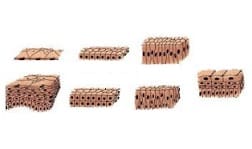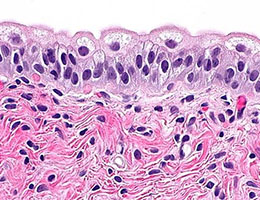 The etymological journey of epithelium begins with a compound Greek word: epi (which translates as “about” ) and thēlḗ (a term that refers to “nipple” ). These concepts came into scientific Latin as epithelium . At first, the idea referred to the tissue that is part of the mammary papilla.
The etymological journey of epithelium begins with a compound Greek word: epi (which translates as “about” ) and thēlḗ (a term that refers to “nipple” ). These concepts came into scientific Latin as epithelium . At first, the idea referred to the tissue that is part of the mammary papilla.
Then, as time went by, the notion of epithelium began to be used to name the tissue composed of cells that maintain direct contact, whose function is to line ducts, cavities and the surface of the organism . It can be said, therefore, that the epithelium or epithelial tissue is formed by the union of layers of cells that cover the free organic spaces.
The organs , glands and mucous membranes have epithelium. When the epithelium gives rise to the sense organs, it is called sensory epithelium . The epithelium that makes up the secretory sector of the glands, on the other hand, is called glandular epithelium or secretory epithelium . The epithelium that houses the melanin-bearing cells, on the other hand, is the pigment epithelium , while the epithelium that makes up the outer layer of the mucous membranes and epidermis is called the lining epithelium .
Among the characteristics of the epithelium, it is worth mentioning that it does not have blood vessels (it is avascular). Lacking its own irrigation, this tissue needs the metabolites and oxygen it obtains from the connective tissue vessels that provide support.
The close cohesion of the cells that compose it and the capacity for regeneration are other properties of this type of tissue, which fulfills functions of protection and absorption and secretion of substances.
It is possible to recognize several classifications of epithelia, depending on the criteria taken into account. Let's look at some of the most important ones below, starting with the one that is carried out based on its function :
* squamous epithelium : it is also known as lining epithelium , and it is the one that covers the cavities and ducts of the body on the inside or the skin on the outside. Its cells are located in the form of sheets;
* glandular epithelium : it has a considerable capacity for the production of substances. Its main function is the formation of glands;
* sensory epithelium : the so-called sensory cells are part of it;
* respiratory epithelium : it is the one associated with the airways ;
* intestinal epithelium : it has independent cells, which have different sensory functions.
If we take into account their shape, then epithelial-type cells can be classified into the following three groups:
* squamous epithelium : it is also known as squamous epithelium and is made up of flat cells, whose height is much smaller than their width. Its nucleus has a flattened shape;
* Cubic epithelium : It is made up of cubic-shaped cells that have the same proportion of width and height. Its core is round;
 * Prismatic epithelium : it is also called cylindrical and its cells are columnar , a name that is due to the fact that its height considerably exceeds its width. Its nucleus is ovoid.
* Prismatic epithelium : it is also called cylindrical and its cells are columnar , a name that is due to the fact that its height considerably exceeds its width. Its nucleus is ovoid.
A third possible criterion for classifying epithelia is the number of cell layers that make it up. In this case, we have the following three types:
* simple epithelium : another name for this type of epithelium is monostratified , and it has a single layer of cells;
* stratified epithelium : this includes those that have more than one layer of cells, which must be ordered, forming various lines of nuclei;
* pseudostratified epithelium : it is formed by a single layer of cells but its shape does not have a specific order.
On the other hand, there is the ciliated epithelium , whose cells have cilia, the flagellated epithelium , which has flagella responsible for agitating the fluid of the tubular organs, and the epithelium with microvilli , which have an absorptive function to allow substances to pass. through its structure .
